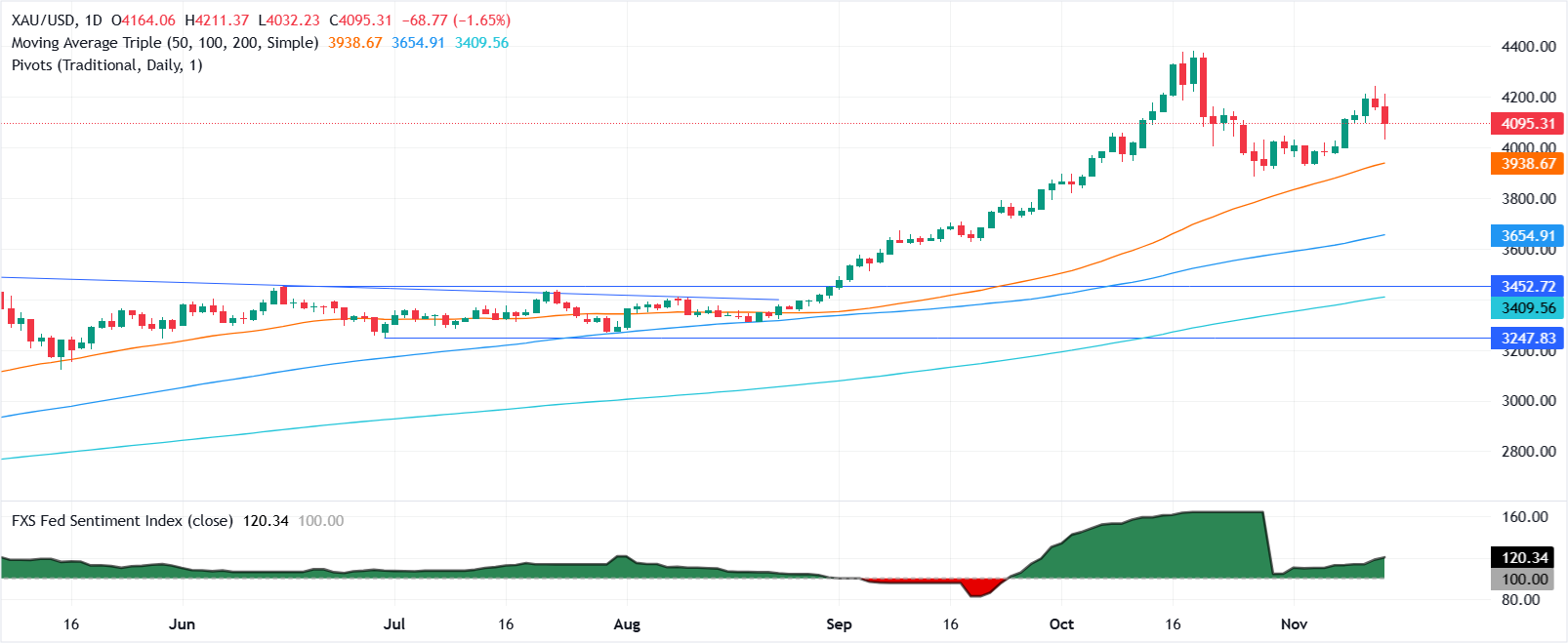Gold plunges below $4,100 as hawkish Fed rhetoric trims December rate-cut bets
- Gold dips to $4,032 before slight rebound, trading below $4,100 as December cut odds drop to 50%.
- Fed officials, including Schmid, warn inflation remains 'too hot,' fueling pause speculation in easing cycle.
- Markets await delayed US data, hoping weaker indicators justify further Fed accommodation.
Gold (XAU/USD) tumbles near 2% on Friday yet it has recovered after reaching a daily low of $4,032 on growing speculation that the Federal Reserve might pause its easing cycle as most officials struck a hawkish message.
Bullion prices fell during the day sharply but at the time of writing, XAU/USD trades beneath $4,100 down 1.72%.
XAU/USD slides nearly 2% as policymakers push back on easing expectations and traders reassess odds of a December cut
Money markets trimmed their bets for the December meeting from 72% a week ago to about a 50% chance, with most officials worried about inflation, despite acknowledging the labor market softness.
Kansas City Fed Jeffrey Schmid said, “inflation is too hot” and added that policy is where it should be. In the last meeting he was one of the two dissenters, with Fed Governor Miran eyeing 50 bps of cuts, Schmid opted to hold rates unchanged.
Even though the largest government shutdown should get economic data flowing, the Bureau of Labor Statistics (BLS) has not released a statement of tentative dates of data releases. In its website is read that they “will announce revised news release dates on this page as they become available.”
Traders remain hopeful that fresh data would indicate that further easing is needed due to the deterioration of the US economy.
As of writing, US Treasury yields are edging up, while Greenback trims some of its Thursday’s losses that pushed the US Dollar Index (DXY) far from 100.00, reaching a weekly low of 98.99.
Daily market movers: Gold tumbles on traders booking profits, elevated yields
- The US Dollar Index (DXY), which tracks the performance of the buck’s value against other six currencies, rose a modest 0.08% at 99.31 as of writing.
- Conversely, US Treasury yields are rising, with the 10-year US Treasury note up two and a half basis points to 4.10%. US real yields — which correlate inversely to Gold prices, also surging nearly three bps to 1.862%.
- Fed Governor Stephen Miran insisted on his uber dovish rhetoric, saying that the data should make the Fed more dovish, not less and added that it is a mistake to make policy on past data.
- Kansas City Fed Jeffrey Schmid added that “y rationale for dissenting against the rate cut at the last meeting and one that continues to guide my thoughts as I head into the meeting in December. “I view the current stance of monetary policy as being only modestly restrictive, which is about where I think it should be.”
Technical outlook: Gold plummets on volatile session below $4,100
Gold’s uptrend remains in place despite diving to a four-day low of $4,032, because it has recovered toward $4,100. Although ending the day above the latter is good, it paves the way for consolidation within the $4,100-$4,200 area.
On the other hand, if XAU/USD stays below $4,100, traders could opt for retesting for the second time in the day, the 20-day Simple Moving Average (SMA) at $4,064 ahead of challenging the October 28 low near $3,886.

Gold FAQs
Gold has played a key role in human’s history as it has been widely used as a store of value and medium of exchange. Currently, apart from its shine and usage for jewelry, the precious metal is widely seen as a safe-haven asset, meaning that it is considered a good investment during turbulent times. Gold is also widely seen as a hedge against inflation and against depreciating currencies as it doesn’t rely on any specific issuer or government.
Central banks are the biggest Gold holders. In their aim to support their currencies in turbulent times, central banks tend to diversify their reserves and buy Gold to improve the perceived strength of the economy and the currency. High Gold reserves can be a source of trust for a country’s solvency. Central banks added 1,136 tonnes of Gold worth around $70 billion to their reserves in 2022, according to data from the World Gold Council. This is the highest yearly purchase since records began. Central banks from emerging economies such as China, India and Turkey are quickly increasing their Gold reserves.
Gold has an inverse correlation with the US Dollar and US Treasuries, which are both major reserve and safe-haven assets. When the Dollar depreciates, Gold tends to rise, enabling investors and central banks to diversify their assets in turbulent times. Gold is also inversely correlated with risk assets. A rally in the stock market tends to weaken Gold price, while sell-offs in riskier markets tend to favor the precious metal.
The price can move due to a wide range of factors. Geopolitical instability or fears of a deep recession can quickly make Gold price escalate due to its safe-haven status. As a yield-less asset, Gold tends to rise with lower interest rates, while higher cost of money usually weighs down on the yellow metal. Still, most moves depend on how the US Dollar (USD) behaves as the asset is priced in dollars (XAU/USD). A strong Dollar tends to keep the price of Gold controlled, whereas a weaker Dollar is likely to push Gold prices up.

